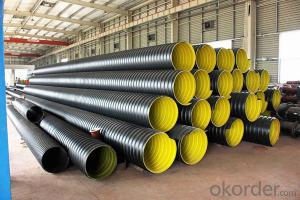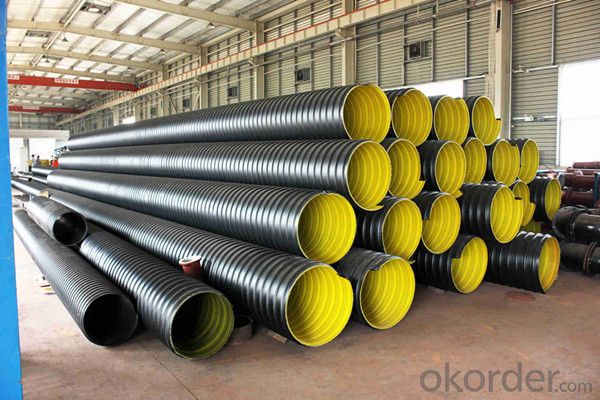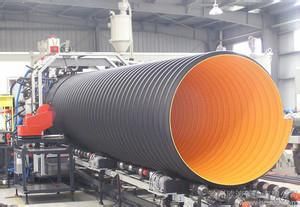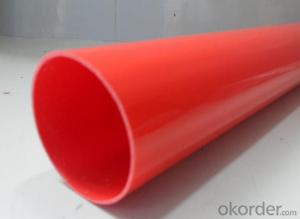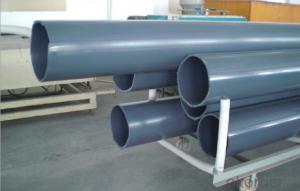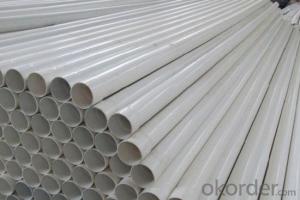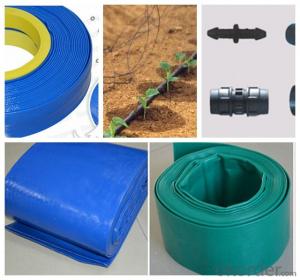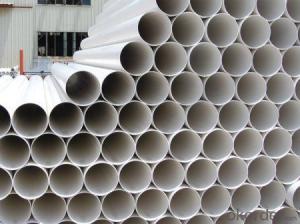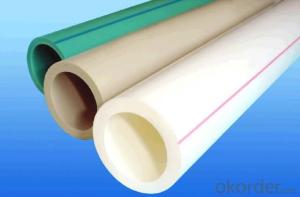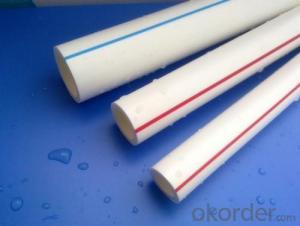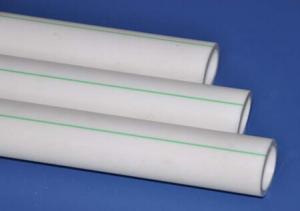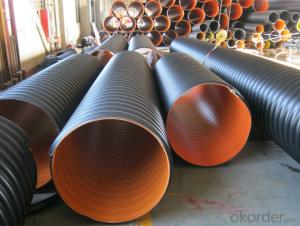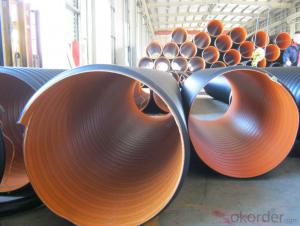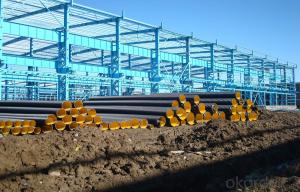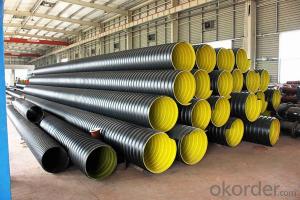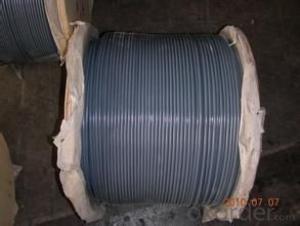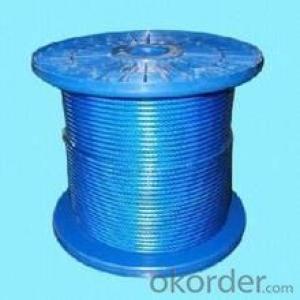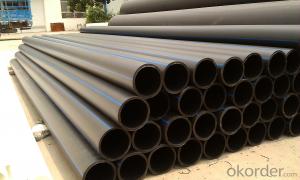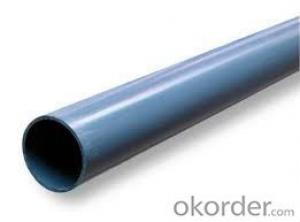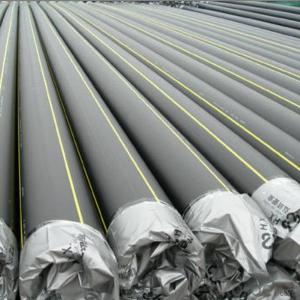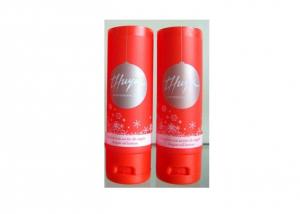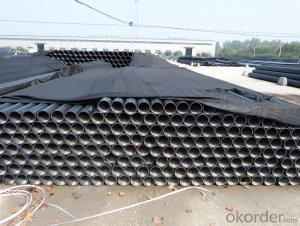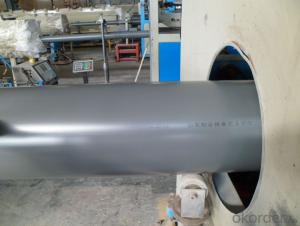PVC Pipe Large Diameter Steel Reinforced Corrugated
- Loading Port:
- Qingdao
- Payment Terms:
- TT or LC
- Min Order Qty:
- 2000 m
- Supply Capability:
- 50000 m/month
OKorder Service Pledge
OKorder Financial Service
You Might Also Like
1.Description of PVC Pipe :
Material: Virgin Rigid PVC resin, no recycle material
Process: vacuum forming extrusion
Color: various colors, we can make color according to Panton card No.
Quality Standard: Smooth surface, no spot, no shrink mark, no surface quality defect.Check from cross section, homogeneous in density, good plasticizing degree, relative chemical/physical property meet customer requirement. We supply different environment protection products to meet different market requirement.
Back working procedure: precise length cutting, drilling/slotting/punching, gold stamping, quality inspection, cleaning, assembling, and packing.
Application:construction, home decoration, stationery&toy, advertising, ornament, etc.
Common Feature: high glossy, water proof, damp proof, termite proof, shock proof, fire retardant, Maintenance free, light weight ,easy to install, economical, durability, recyclable
2.Features of PVC Pipes :
1) Structure Engineering, home water supply and drainage
2) Water drainage/supply system
3) for Agriculture Irrigation, aquaculture
4) Strong mechanical strength: Good resistance to water pressure, outside impact and pressure, is satisfied under any conditions.
5) Good electrical insulation: excellent insulation nature against electricity. the pvc pipe can be served as conduits and pipes in construction cable and wire.
6) Water quality unaffected: The solution tests on the PVC pipe show no affect on water quality when the water flows through is. It is considered the best piping material for running water works.
7) Simple installation: Very easy to connect, thus much time and laborcost may be saved.
3.PVC Pipe Images:
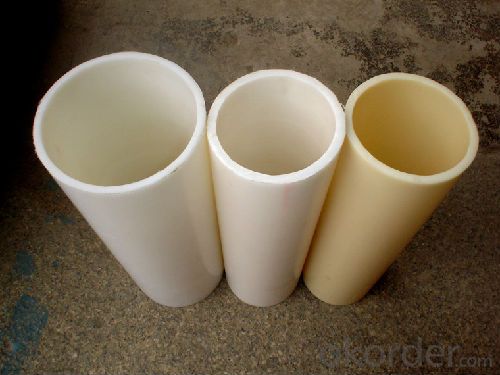
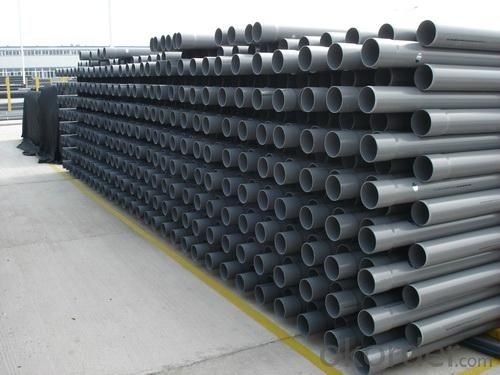
4.Specifications of the PVC Pipe:
1) Material: pvc pipe unplasticized polyvinyl chloride
2) Standard: GB, ISO9001, ISO14001
3) Color: white pvc pipe, grey pvc pipe , etc.
4) Specific Gravity:g/cm3, 20(C): 1.35 - 1.55
5) Vicat Softening Temperature: (C) >=79
6) Longitudinal Reversion: %, 150(C) <=5< span=""><>
7) Dichloromethane Resistance Test: No attack
8) Falling Weight Impact Test: TIR, %, 0(C) <=10< span=""><>
9) Tensile Yield Strength: Mpa >=40
5.FAQ
Q:What is you MOQ?
A:As customer’s request.
Q:What is the production ability? or delivery time?
A:Our production ability support 40HQ order finish in one week.
Q:What is the regular shipping port?
A:Tianjin or Shanghai.
Q:What is your payment?
A:TT or CC.
Q:Can we have sample?
A:Sample free, freight cost you.
- Q: it has one hose connected to one end and two hoses on the other end. think it might have something to do with heater core or something.
- the single end is attached to the lower radiator hose the double end one hose goes to the lower part of the intake and the other goes to the heater core this is just a transfer tube across the front of the vehicle
- Q: How to clean the moss in the plastic pipe?
- Water algaecide is suitable for all kinds of open and closed industrial circulating water system and sterilization of various heat conduction system, water algae treatment, can effectively kill moss, heterotrophic bacteria, iron bacteria and algae was more than 95%, using this agent can prevent the corrosion and blocking of moss, bacteria and algae caused by equipment the increase of circulating water system work efficiency, prolong the service life of the equipment.
- Q: What are the common diameters of oil line plastic tubes?
- The common diameters of oil line plastic tubes typically range from 1/8 inch to 1 inch.
- Q: It seems to me that if this country is serious about environmental issues, we should not be packaging products in anything that cannot be recycled. The world is becoming one big garbage dump!
- Most kinds of plastics can be recycled if someone is willing to go to the trouble to set up the systems to do so. However, some kinds of plastics are either more difficult (expensive) to recycle, or the markets for the recycled plastic are too small or of such low value that nobody is willing to process them. Sometimes the plastic in a package may be of a type that is commonly recycled, but the manufacturer may not put the necessary recycling symbol on it. This can be true of very small packages. Just because a plastic package is technically recyclable does not mean it will be recycled. Mixed plastic recyclables are sent to sorting centers where the more common and more valuable types are segregated. The remaining plastics that are not worth recycling are either sent to landfill or sometimes lumped together and recycled into lower value materials where blends of different types of plastic are acceptable (e.g. construction materials). And of course not everybody recycles. Many people just throw recyclable materials in the general trash. And keep in mind that some packages, especially for food and personal care products, are made of several layers of different types of plastics. These can't be recycled because the different types of plastics can't be separated.
- Q: What does "DN" and "Dn" mean in plastic pipes? And de?
- DN means nominal diameter or nominal diameter. Is the general caliber of various tube and pipe accessories, with a nominal diameter of the tube and pipe accessories can connect with each other, with interchangeability. It is not a real sense of the pipe diameter or diameter, although its value is closer with the pipe diameter or equivalent;De refers to the outer diameter,DN and Dn mean the same thing. Like De and de
- Q: What is the purpose of dialysis tubing in the medical world?
- It would help if you clarified your question but what came to my mind was the tubing used for peritoneal dialysis. Peritoneal dialysis is a type of dialysis that uses the peritoneum as the semipermeable membrane. The peritoneum is the membrane that surrounds the human gut – stomach, intestines, liver, etc – dialysis is accomplished by filling the space around those organs with dialysate so that waste solutes can dialyze from the blood into the dialysate. In order to fill and empty the dialysate from the gut you need to have a tube placed by a surgeon – a peritoneal catheter. From the outside that peritoneal catheter looks like a plastic tube sticking out of the belly, its purpose is to allow dialysis.
- Q: I'm building a computer and I got to the liquid cooling option and I can't decide between copper tubing and plastic tubing. I've seen plastic tubing and know that plastic is easier to detach, but I think copper might cool the components better. Any suggestions?(Note-this is not a budget build by any means-I want to know which one performs better, not what's the best bang for your buck)
- Copper is better bang but needs to be bent for each component. Plastic is flexible and just needs to be cut to length
- Q: Are plastic tubes suitable for automotive applications?
- Yes, plastic tubes are suitable for automotive applications. They are lightweight, durable, and resistant to corrosion, making them ideal for various automotive systems such as fuel lines, coolant hoses, and air intake systems. Additionally, plastic tubes can be easily molded into different shapes and sizes, allowing for customization and efficient installation in vehicles.
- Q: Are plastic tubes resistant to impact or pressure?
- Plastic tubes can vary in their resistance to impact and pressure depending on the specific type and quality of plastic used. Some plastic tubes can be designed to withstand high impact and pressure, while others may be more prone to damage. It is important to consider the intended use and specifications of the plastic tube to determine its level of resistance.
- Q: Are plastic tubes resistant to ultrasonic cleaning?
- Yes, plastic tubes are generally resistant to ultrasonic cleaning. However, the specific resistance may vary depending on the type of plastic used in the tubes.
Send your message to us
PVC Pipe Large Diameter Steel Reinforced Corrugated
- Loading Port:
- Qingdao
- Payment Terms:
- TT or LC
- Min Order Qty:
- 2000 m
- Supply Capability:
- 50000 m/month
OKorder Service Pledge
OKorder Financial Service
Similar products
Hot products
Hot Searches
Related keywords
